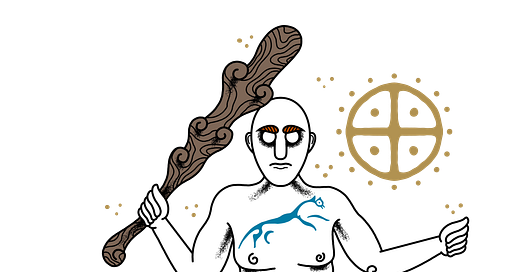Wessex, a region steeped in history and folklore, holds a unique treasure: chalk hill figures. These colossal images carved into the hillsides have captivated imaginations for centuries, sparking debates about their origins and purpose. From the famously phallic Cerne Abbas Giant to the elegant Uffington White Horse, these figures are more than just impressive sights – they're windows into the past, whispering tales of ancient gods, forgotten battles, and local legends.
The Cerne Abbas Giant: A Symbol of Mystery and Fertility
Perhaps the most iconic (and certainly the most provocative) of the Wessex chalk figures is the Cerne Abbas Giant. This 55-meter tall nude figure, wielding a club and sporting a rather prominent phallus, stands guard over the village of Cerne Abbas in Dorset. While the earliest written evidence dates back to the 17th century, recent studies suggest the giant's origins lie between 700 and 1100 AD, placing it firmly in the Anglo-Saxon period.
Theories about the giant's identity abound. Some believe it represents a pagan deity, possibly a lesser-known Anglo-Saxon god named Heleth. Others have suggested connections to Hercules or even Oliver Cromwell. Interestingly, evidence suggests the giant was originally clothed, and his now-famous phallus was a later addition, perhaps evolving from a belly button circle.
Beyond its historical significance, the Cerne Abbas Giant is intertwined with local folklore. Victorian-era beliefs linked the giant to fertility rituals, with claims that couples seeking to conceive would engage in intercourse atop his chalky member. More recently, the giant has become a symbol of local pride, even inspiring a suggestion that it should feature on the Dorset flag.
The Uffington White Horse: Galloping Through Time
Another iconic figure gracing the Wessex landscape is the Uffington White Horse. This stylized horse, carved into a hillside in Oxfordshire, is believed to be much older than the Cerne Abbas Giant, dating back to the Bronze Age. Its elegant, flowing lines give the impression of a horse galloping across the hillside, inspiring music, poetry, and even speculation that it influenced the banners of the Rohirrim in Tolkien's Lord of the Rings.
The Uffington White Horse, like its giant counterpart, is shrouded in mystery. Some scholars link it to the Celtic goddess Epona, while others connect it to King Arthur or Alfred the Great. Recent archaeological discoveries near the horse have unearthed human remains, suggesting possible links to human sacrifice and the community that created the figure.
Folklore surrounding the Uffington White Horse includes tales of the horse coming to life and galloping across the sky to be reshod by the legendary Wayland Smith. Another legend claims that wishes can be granted by spinning around three times in the horse's eye.
Other Notable Chalk Figures of Wessex
Wessex is home to several other intriguing chalk figures, each with its own unique story:
The Hackpen White Horse: A relatively modern white horse, cut in 1838 to commemorate the coronation of Queen Victoria. This figure is associated with local fairy lore, including tales of fairies stealing children and a white hart being led away on a merry dance.
The Long Man of Wilmington: This enigmatic figure, holding two staves, stands rigid on a hillside in East Sussex. Its origins are debated, with theories ranging from Iron Age chieftain to Anglo-Saxon deity. Local folklore tells of a black dog guarding the figure and a giant who fell and broke his neck on the hill.
The Alton Barnes White Horse: Cut in 1812, this white horse has a colorful history, including a con artist painter and a zebra transformation prank. It stands near Adam's Grave, a Neolithic long barrow with connections to Anglo-Saxon battles and the god Odin.
The Bulford Kiwi: A more recent addition, this 130-meter tall kiwi was carved in 1919 by New Zealand soldiers awaiting repatriation after World War I.
The Enduring Appeal of Chalk Figures
The chalk hill figures of Wessex continue to fascinate and intrigue. Their sheer size and mysterious origins inspire awe, while their connection to folklore and local legends adds a layer of magic and wonder. Whether they were created to honor gods, mark territory, commemorate victories, or simply impress onlookers, these figures are a testament to the ingenuity and artistry of our ancestors. They stand as enduring symbols of Wessex, etched into the landscape and into our collective imagination.
Check out our podcast about chalk hill figures here
You can also watch our podcast on our YouTube channel here



